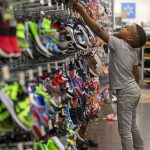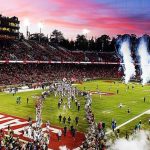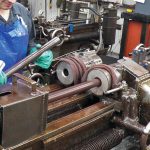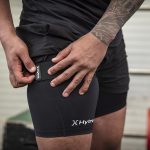Sears Holdings Corporation reported a net loss of $508 million, or $4.68 a share, compared to a net loss of $250 million, or $2.33, for the second quarter of 2017.
Adjusted EBITDA was a loss of $112 million in the second quarter of 2018 as compared to a loss of $66 million in the prior year second quarter.
The company generated total revenues dropped 25.6 percent to approximately $3.2 billion during the second quarter of 2018 compared with revenues of $4.3 billion in the prior year quarter with store closures again significantly contributing to the year over year decline. Total comparable store sales declined 3.9 percent during the quarter reflecting Kmart-comparable store sales declining 3.7 percent and Sears-comparable store sales declining 4.0 percent. In addition to delivering improvement in comparable stores sales trend in the second quarter compared to the first quarter, Sears said it achieved positive comparable store sales in several categories at both Kmart and Sears formats, including apparel, footwear and jewelry.
Edward S. Lampert, chairman and chief executive officer of Holdings, said, “While we are encouraged by the improved comparable stores sales trend we experienced in the second quarter and the positive comparable store sales of 3.0 percent and 2.5 percent achieved in the months of July and August, respectively, we have yet to achieve our goal of returning the company to profitability. We continue to close unprofitable stores, and we are hopeful that we can stabilize our store base at a meaningful level in the near future. Our goal is to right-size our store footprint to a solid base from which we can operate and grow profitably while leveraging our online and Shop Your Way platforms.”
“As we enter the second half of 2018, we remain focused on identifying additional opportunities to streamline operations and reduce operating expenses while staying focused on our Best Members, Best Categories and Best Stores. We have a responsibility to explore opportunities to unlock the full potential of our assets for our shareholders including third-party partnerships or the sale of our businesses. We will also continue to seek opportunities to improve value and experience for our members through our Integrated Retail Strategy and Shop Your Way membership program which remain our key priorities. We believe these initiatives will help us to strengthen the company, improve financial performance and better position us for the future.”
Highlights include:
• Expansion of the Sears Auto Center tire installation program with Amazon.com which is now available nationwide including Alaska and Hawaii;
• Expansion of its online marketplace as Sears strategically added top brands and popular products to sears.com sold by third-party sellers including floor care brands Hoover, Dirt Devil and Oreck; men’s and women’s national shoe brands Dockers, G.H. Bass & Co. and Lucky Brand and precious metals including gold, silver, platinum and palladium bullion bars, rounds and coins, as well as premium bullion products;
• Launch of a nationwide, fully integrated marketing campaign supporting The MOREs of Kenmore sold exclusively at Sears to highlight all the outstanding offers available to members who purchase Kenmore products and
• Strategic partnership with the hotel booking site Rocketmiles to launch Shop Your Way Hotels which will give members exclusive access to reserve rooms at more than 400,000 hotels around the world and an average of $50 CASHBACK in Shop Your Way points for each booking.
Rob Riecker, chief financial officer of Holdings, said, “During the quarter, we continued to focus on improving profitability and generating additional liquidity. By focusing on our Best Stores, aligning our overall cost structure to our core stores and optimally using our real estate assets as collateral, we intend to provide the runway necessary to continue our transformation to a profitable integrated retail company. We will continue to evaluate opportunities to optimize our balance sheet and capital structure as we move forward to effectuate our transformation.”
Financial Position and Liquidity Update
At August 4, 2018, the company had utilized approximately $780 million of its $1.5 billion revolving credit facility due in 2020 consisting of $660 million of borrowings and $120 million of letters of credit outstanding. The amount available to borrow under its credit facility was approximately $98 million which reflects the effect of its springing fixed charge coverage ratio covenant and the borrowing base limitation in its revolving credit facility which varies based on its overall inventory and receivables balances. Availability under its general debt basket was approximately $650 million at August 4, 2018.
The company’s total cash balances were $441 million at August 4, 2018 including restricted cash of $248 million which relates to amounts deposited in escrow for the benefit of its pension plans compared to $336 million at February 3, 2018 which included restricted cash of $154 million. Short-term borrowings totaled $1.3 billion at August 4, 2018 consisting of $660 million of revolver borrowings, $570 million of line of credit loans and $24 million of borrowings under the secured loan.
Total long-term debt (including current portion of long-term debt and capital lease obligations) was $3.7 billion and $3.2 billion at August 4, 2018 and February 3, 2018, respectively.
Sears said it continued to take actions during the second quarter of 2018 to improve liquidity. On June 4, 2018, the company entered into a Third Amended and Restated Loan Agreement (the “Consolidated Loan Agreement”) which amended and restated the Second Amended and Restated Loan Agreement dated as of October 18, 2017 under which the company received an additional advance in an aggregate principal amount of approximately $186 million which was used to repay the loans outstanding under its April 2016 secured loan facility. After giving effect to the additional advance, the aggregate principal amount of the loan outstanding under the Consolidated Loan Agreement as of June 4, 2018 was approximately $779 million. The Consolidated Secured Loan Facility matures on July 20, 2020.
In addition, on June 29, 2018, the company entered into a Second Amendment to its Credit Agreement with UBS AG, Stamford Branch that increased the loan-to-value cap applicable to the aggregate principal amount of the Secured Loan, the Mezzanine Loan and the Additional Mezzanine Loans that may be incurred under the revolving credit facility and the Mezzanine Loan Agreement from 55 percent to 69 percent. The company subsequently incurred an aggregate of $125 million in additional Mezzanine borrowings.
In December 2017, the company had entered into an agreement to extend the remaining balance of an existing term loan, which was scheduled to mature in 2018, to January 20, 2019 with the option to further extend the maturity to July 20, 2019. Subsequent to the end of the second quarter of 2018, the company chose not to exercise the option to extend the maturity for another six months and paid down the remaining balance of $95 million of the term loan.
On August 30, 2018, the company entered into an amendment to its Pension Plan Protection and Forbearance Agreement pursuant, to which the Pension Benefit Guaranty Corporation released its liens on certain real estate properties in exchange for a $32 million contribution to an escrow for the benefit of the company’s pension plans. Subsequently, on September 12, 2018, the company entered into an amendment to the Consolidated Loan Agreement pursuant to which the company borrowed an additional $75 million and pledged certain of the released properties, together with other properties, as additional collateral.
In addition, on August 31, 2018, the company entered into an amendment to the Credit Agreement with UBS AG, Stamford Branch, pursuant to which, among other things, the company borrowed an additional $113 million and extended the maturity of the existing $30 million loan outstanding under the Credit Agreement to August 30, 2019 which is also the maturity date of the additional loan.
During the first half of 2018, Sears said it generated net cash proceeds of nearly $440million from real estate transactions with over $310 million of proceeds used to pay down real estate-backed loans. The remaining net proceeds from the real estate transactions were used to reduce the outstanding balance on its revolving credit facility.
Sears said it will continue to pursue additional real estate transactions to unlock the value of its real estate assets and explore means to reduce amounts due on the real estate-backed loans outstanding (and/or defer the interest payable thereon). The company is also actively considering means of improving the terms of over $1.0 billion of its outstanding indebtedness, including extending the maturity thereof and reducing the interest payable thereon.
Strategic Actions
As previously announced on August 22, 2018, Sears identified 46 unprofitable stores which it expects to close during the fourth quarter of 2018 advancing the company’s ongoing efforts to streamline its operations, strengthen its capital position and focus on its Best Stores. Sears said it continue to evaluate its network of stores which is a critical component to its integrated retail transformation and will make further adjustments as needed.
As part of the company’s ongoing efforts to simplify its organization structure and in recognition of the fact that Sears is becoming a smaller company, Sears said it continues to evaluate all areas of its cost structure and intend to pursue additional measures to achieve cost savings including greater consolidation of the Sears and Kmart corporate and support functions. Sears said it expects these initiatives to result in annualized cost savings of approximately $100 million. This is in addition to the company’s $200 million of annualized cost savings initiative announced earlier this year that Sears said it has exceeded. These incremental cost actions, along with the completion of the various financing and asset sale transactions, are intended provide the company with the path forward to transform the company successfully, while continuing to focus on its key priorities: Shop Your Way and Integrated Retail as well as on its Best Members, Best Categories and Best Stores.
As previously announced on May 14, 2018, a special committee of the board of directors (the “Board”) of the company (the “Special Committee”) is overseeing a formal process to explore the sale of the Kenmore brand and related assets, the Sears Home Improvement Products business of the Sears Home Services division and the Parts Direct business of the Sears Home Services division (collectively, the “Sale Assets”). As previously reported, the Board received a letter from ESL Investments, Inc. (“ESL”) expressing the view that the company should pursue a divestiture of the Sale Assets in order to maximize their value and expressing interest in participating as a purchaser of all or a portion of the Sale Assets should the company do so. The Board established the Special Committee, which consists solely of independent directors, and is advised by independent advisors, to evaluate any proposals that may be received from ESL with respect to the Sale Assets, to actively solicit third-party interest in the Sale Assets and to explore any other alternatives with respect to the Sale Assets that may maximize value for the company.
On August 14, 2018 the Special Committee received a non-binding proposal letter from ESL to acquire the Kenmore brand and related assets and the Sears Home Improvement Products business of the Sears Home Services division, each subject to various conditions including obtaining debt financing and, in the case of Kenmore, obtaining equity financing on terms acceptable to ESL. The Special Committee is evaluating the proposal and potentially other proposals as part of its formal process.
Sears said it also continue to explore ways to unlock value across a range of other assets and to maximize the value of its Sears Home Services, Innovel and Sears Auto Centers businesses as well as the DieHard brand. OptionsSears said it is exploring include partnerships, sales or other means of externalization that could expand distribution of its brands and service offerings.













